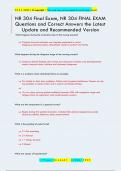2 0 2 4 /2025 | © copyright | This work may not be copied for profit gain Excel!
NR 304 Final Exam, NR 304 FINAL EXAM
Questions and Correct Answers the Latest
Update and Recommended Version
What happens during the evaluation step of the nursing process?
→ Progress towards outcomes, use ongoing assessment to revise
diagnoses/outcomes/plans, disseminate results to patient and family
What happens during the diagnosis stage of the nursing process?
→ Compare clinical findings with normal and abnormal variation and developmental
events, interpret data, validate and document diagnoses.
What is a problem center database? Give an example.
→ For limited or short term problems. Collect mini/targeted databases. Focuses on only
one problem or body system and is used in all clinical settings.
→
→ Ex: two days post-op patient suddenly becomes SOB with congestive cough and
fatigue; focus on respiratory and cardiovascular systems
What are the components of a general survey?
→ Begins during first patient encounter.. Includes their physical appearance, body
structure, mobility, behavior, body measurements
What is the grading of pulse force?
→ 3+ Full, bounding
→ 2+ Normal
→ 1+ Weak, thready
→ 0 Absent
What are causes of hypotension?
1|Page| GradeA+ | 2 0 0 2 5
,2 0 2 4 /2025 | © copyright | This work may not be copied for profit gain Excel!
→ Acute myocardial infarction, shock, hemorrhage, vasodilation, Addison's disease
What is the blood pressure measurement for hypotension?
→ Less than 95/60 mmHg
Acute myocardial infarction and shark causes a _____ cardiac output which leads to
hypertension?
→ Decreased
Hemorrhage causes a _____ total blood volume that leads to hypotension
→ decreased
Vasodilation causes a ____peripheral vascular resistance that leads to hypotension
→ decreased
Addison's disease (hypofunction of adrenal gland) is caused by a ___ circulating aldosterone
which causes hypotension
→ decreased
How do you count respirations?
→ Count while assessing radial pulse to make patient unaware that you were counting
respirations. Count for 30 seconds of normal or 1 minute if abnormal
What are the effects of smoking on blood pressure?
→ Vasoconstriction of the arteries which makes your blood pressure increase. Long-term
cause of hypertension
1|Page| GradeA+ | 2 0 0 2 5
,2 0 2 4 /2025 | © copyright | This work may not be copied for profit gain Excel!
What is the ABCDEF skin lesions mean?
→ Asymmetry, border irregularity, color variation, diameter greater than 6mm,
elevation/evolution, funny looking
What are the physiological changes associated with acute pain responses?
→ Tachycardia, elevated blood pressure, increased cardiac output, hypoxia,
hypoventilation, atelectasis, decreased cough, nausea, vomiting, ileus, oliguria, urinary
retention, spasm, joint stiffness, increased adrenergic activity, fear, anxiety, fatigue,
impaired immunity, wound healing
How do you assess for clubbing?
→ Put nail beds back to back and view profile sign index. Normal is 160°. Early clubbing
is 180° and lake clubbing is anything less than 160°
What patients does clubbing occur?
→ Smoking, lung cancer, pulmonary disease, congenital cyanotic heart disease
How do you detect pallor in a light skinned patient?
→ Generalized pallor
How do you detect pallor in a dark skinned patient?
→ Ashen gray, dull, loss of glow, cool to palpation
How do you detect jaundice in a light-skinned patient?
→ Yellow sclera, hard palate, skin, mucous membranes
How do you observe jaundice in a dark skinned patient?
1|Page| GradeA+ | 2 0 0 2 5
, 2 0 2 4 /2025 | © copyright | This work may not be copied for profit gain Excel!
→ Observe the palms, hard and soft palates
How do you observe cyanosis in a light skinned patient?
→ Dusky blue appearance
How do you observe cyanosis in a dark skinned patient?
→ Dullness, check conjunctiva, oral cavity, nails
How do you observe erythema in a light skin patient?
→ Red or bright pink color
How do you observe erythema in a dark skinned patient?
→ Purpleish tinge, difficult to observe, palpate for warmth
What is the name and characteristics of a stage one pressure injury?
→ Stage 1 non-blanchable erythema
→ Intact skin with a localized area of non-blanchable erythema
What is the name and characteristics of a stage 2 pressure injury?
→ Stage 2 partial thickness skin loss
→ Partial skin loss with an exposed dermis. Pink/red and moist visible wound base. Looks
like a ruptured blister. Usually associated with moisture. Slough and eschar not noted.
What is the name and characteristics of a stage 3 pressure injury?
1|Page| GradeA+ | 2 0 0 2 5




